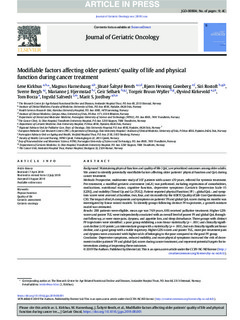Modifiable factors affecting older patients' quality of life and physical function during cancer treatment
| dc.contributor.author | Kirkhus, Lene | |
| dc.contributor.author | Harneshaug, Magnus | |
| dc.contributor.author | Saltyte Benth, Jurate | |
| dc.contributor.author | Grønberg, Bjørn Henning | |
| dc.contributor.author | Rostoft, Siri | |
| dc.contributor.author | Bergh, Sverre | |
| dc.contributor.author | Hjermstad, Marianne Jensen | |
| dc.contributor.author | Selbæk, Geir | |
| dc.contributor.author | Wyller, Torgeir Bruun | |
| dc.contributor.author | Kirkevold, Øyvind | |
| dc.contributor.author | Borza, Tom | |
| dc.contributor.author | Saltvedt, Ingvild | |
| dc.contributor.author | Jordhøy, Marit Slaaen | |
| dc.date.accessioned | 2020-01-16T13:20:24Z | |
| dc.date.available | 2020-01-16T13:20:24Z | |
| dc.date.created | 2019-08-27T09:57:21Z | |
| dc.date.issued | 2019 | |
| dc.identifier.issn | 1879-4068 | |
| dc.identifier.uri | http://hdl.handle.net/11250/2636672 | |
| dc.description.abstract | Background Maintaining physical function and quality of life (QoL) are prioritized outcomes among older adults. We aimed to identify potentially modifiable factors affecting older patients' physical function and QoL during cancer treatment. Methods Prospective, multicenter study of 307 patients with cancer ≥70 years, referred for systemic treatment. Pre-treatment, a modified geriatric assessment (mGA) was performed, including registration of comorbidities, medications, nutritional status, cognitive function, depressive symptoms (Geriatric Depression Scale-15 [GDS]), and mobility (Timed Up and Go [TUG]). Patient-reported physical function (PF)-, global QoL-, and symptom scores were assessed at baseline, two, four, and six months by the EORTC Quality of Life Core Questionnaire-C30. The impact of mGA components and symptoms on patients' PF and global QoL scores during six months was investigated by linear mixed models. To identify groups following distinct PF trajectories, a growth mixture model was estimated. Results 288 patients were eligible, mean age was 76.9 years, 68% received palliative treatment. Higher GDS-scores and poorer TUG were independently associated with an overall level of poorer PF and global QoL throughout follow-up, as were more pain, dyspnea, and appetite loss, and sleep disturbance. Three groups with distinct PF trajectories were identified: a poor group exhibiting a non-linear statistically (p < .001) and clinically significant decline (≥10 points), an intermediate group with a statistically (p = .003), but not clinically significant linear decline, and a good group with a stable trajectory. Higher GDS-scores and poorer TUG, more pre-treatment pain and dyspnea were associated with higher odds of belonging to the poor compared to the good PF group. Conclusion Depressive symptoms, reduced mobility, and more physical symptoms increased the risk of decrements in older patients' PF and global QoL scores during cancer treatment, and represent potential targets for interventions aiming at improving these outcomes. | nb_NO |
| dc.language.iso | eng | nb_NO |
| dc.publisher | Elsevier | nb_NO |
| dc.rights | Attribution-NonCommercial-NoDerivatives 4.0 Internasjonal | * |
| dc.rights.uri | http://creativecommons.org/licenses/by-nc-nd/4.0/deed.no | * |
| dc.title | Modifiable factors affecting older patients' quality of life and physical function during cancer treatment | nb_NO |
| dc.type | Journal article | nb_NO |
| dc.type | Peer reviewed | nb_NO |
| dc.description.version | publishedVersion | nb_NO |
| dc.source.journal | Journal of Geriatric Oncology | nb_NO |
| dc.identifier.doi | 10.1016/j.jgo.2019.08.001 | |
| dc.identifier.cristin | 1718956 | |
| dc.description.localcode | © 2019 The Authors. Published by Elsevier Ltd. This is an open access article under the CC BY-NC-ND license. | nb_NO |
| cristin.unitcode | 194,65,15,0 | |
| cristin.unitcode | 1920,0,0,0 | |
| cristin.unitcode | 194,65,70,0 | |
| cristin.unitcode | 194,65,30,0 | |
| cristin.unitname | Institutt for klinisk og molekylær medisin | |
| cristin.unitname | St. Olavs Hospital HF | |
| cristin.unitname | Institutt for helsevitenskap Gjøvik | |
| cristin.unitname | Institutt for nevromedisin og bevegelsesvitenskap | |
| cristin.ispublished | true | |
| cristin.fulltext | original | |
| cristin.qualitycode | 1 |
Tilhørende fil(er)
Denne innførselen finnes i følgende samling(er)
-
Institutt for helsevitenskap Gjøvik [1588]
-
Institutt for klinisk og molekylær medisin [3426]
-
Publikasjoner fra CRIStin - NTNU [37221]
-
St. Olavs hospital [2441]

